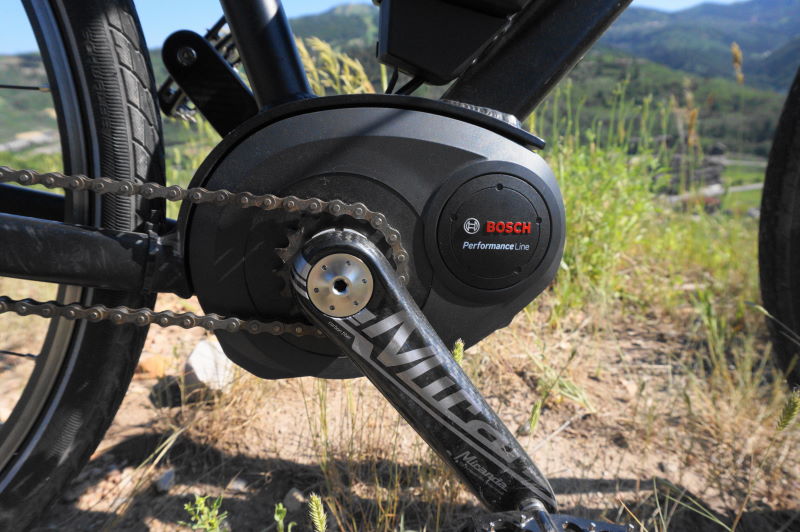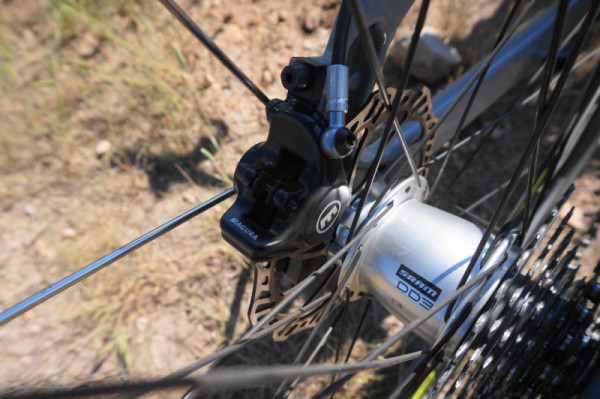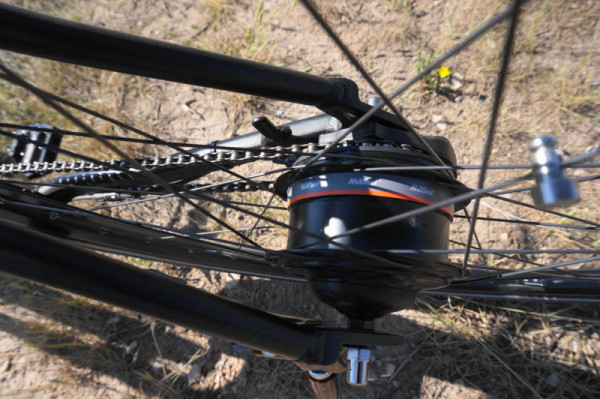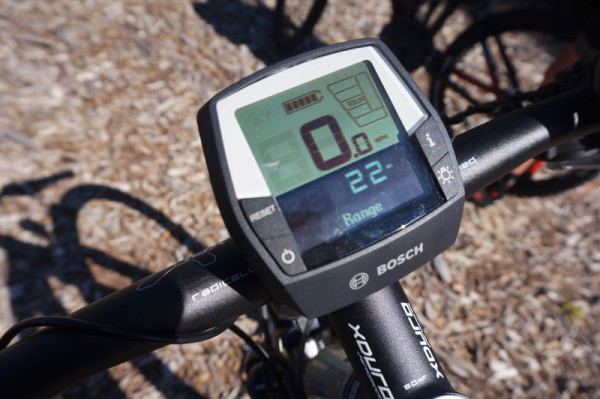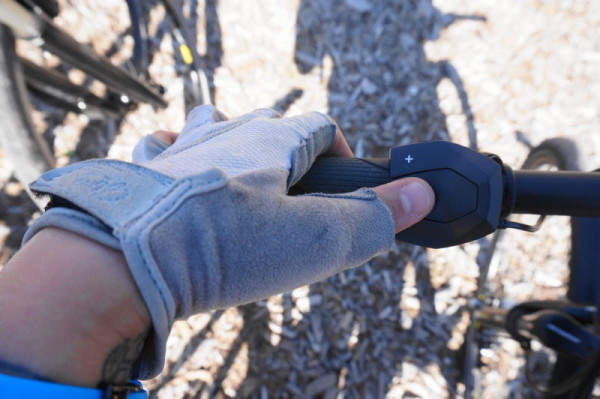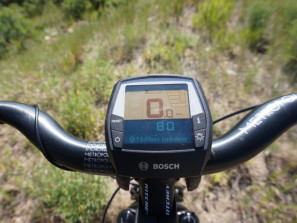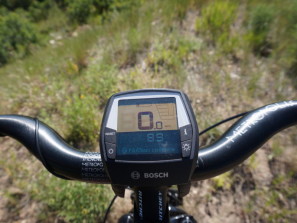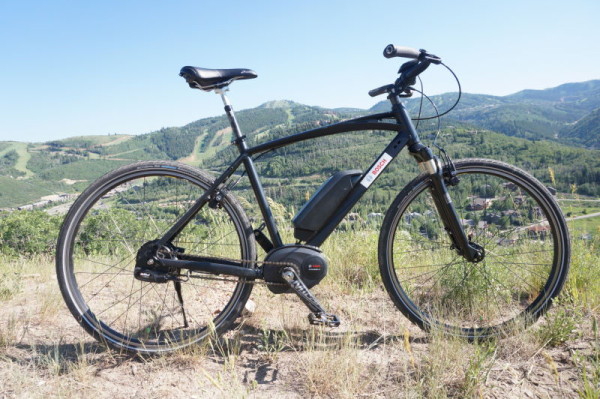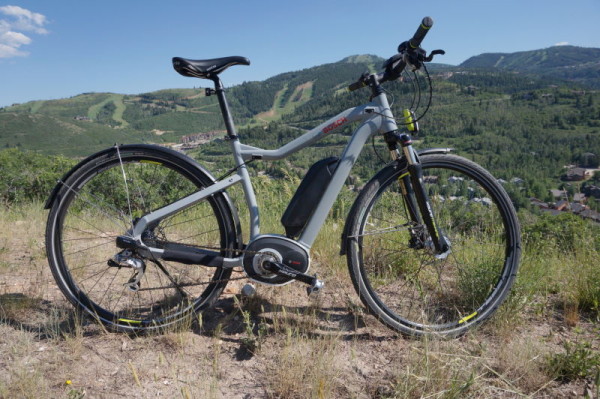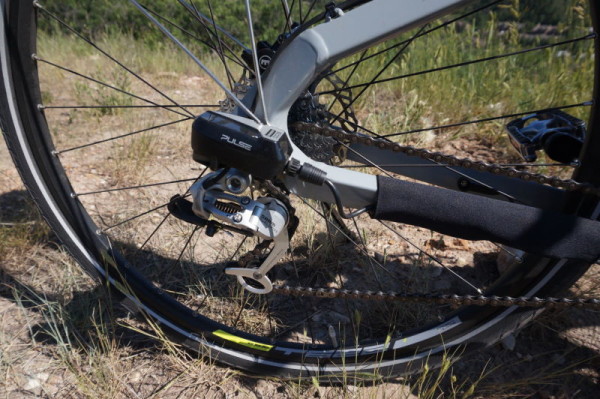Bosch initially entered the American market with their Performance Line, a high capacity battery with high torque drive unit capable of a 20mph top assisted speed. As new product becomes proven in Europe, we will find more of their line trickling across the pond to fill in the gaps of their line-up. The Active Line, a lower torque, higher range, lower price point system designed around the urban e-bike rider will start appearing on e-bikes this Winter. The new Performance CX line, a more compact, smaller Q-Factor, high torque drive system which is already being seen on new e-mountain bikes in Europe will start appearing on domestic e-bikes as soon as this Fall. These systems have been covered on BikeRumor in the past.
Also coming for next year will be a suite of electronic shifting systems, integrated with both the e-bike drive systems and Intuvia on-board computer, Bosch calls “eShift.” SRAM, Shimano, and NuVinci have each partnered with the German e-bike dynamo (see what I did there?) to sync shifting to motors seamlessly. At Press Camp we got a sneak peek of what is to come, both on and off the bike. More to come after the jump.
The eShift systems range from manual to fully automatic, and each has their place depending on the rider context. The Shimano Di2 hub gear system falls on the fully manual end and utilizes the Bosch Intuvia on-board computer as well as the control unit buttons at the grips to activate the Di2 shifting. The on-board computer recommends gearing for maximum efficiency, though the rider is responsible for getting there. This bike was not ride tested.
The SRAM DD3 system (above) is semi-automatic, featuring a 3-speed electrically actuated rear hub and a 9-speed cassette with a cable actuated rear derailleur. Riders choose a gear and the drivetrain uses the internally geared hub to automatically adjust gearing further based off of rider speed.
The NuVinci H|Sync (above) utilizes a continuously variable transmission within the rear hub to shift automatically to allow the rider to maintain set cadence without thinking about it. While the system can be used completely as an automatic, there is an option to manually actuate three gears.
Each eShift system utilizes the Intuvia computer interface or control buttons in some way, whether to fine tune the motor output or as gear shifters.
For all of my urban e-bike testing at press camp, I found a 500ft climb through a neighborhood outside of Park City, Utah. The house on the peak of this development was less than a mile and a half from town, an easy ride on flat terrain but challenging with a pedal bike, let alone a pedal bike with groceries. The slope would give me an opportunity to appreciate the torque curve of each e-bike and a chance to try to exhaust batteries and motors in a relatively extreme case while giving me a sweet spot for photos at the top of the climb. Most of the bikes available at Press Camp were Class 1, pedal assist (no throttle) with a maximum speed of 20mph. While the drive systems were helpful, the climb still required effort. I definitely got a workout in- I just wasn’t completely cooked at the end of it.
Impressions of Bosch Drive Overall:
Both bikes were outfitted with the Performance Drive system. Though the 350W Drive Unit high torque motors (60Nm maximum torque when in the highest assist mode) were great on the climb, they were easily the loudest I experienced at Press Camp. In any kind of traffic, however, the motor was not noticeable. Both frames featured the PowerPack 400, Bosch’s 400Wh/11.0Ah, 36V frame battery, which I barely made a dent in as they have an estimated range of 20 miles in difficult conditions at top speed in Turbo mode (but 100 miles in Eco mode in favorable conditions).
Both bikes featured the Intuvia on-board computer with grip controls. Having never had this system in my hands before, it was awesome to see the whole system with Intuvia in action, actively calculating the range of my ride from the last 90 seconds of riding at a given assist level. This was reassuring because the range numbers felt substantiated, which gave me more confidence in the system when riding in challenging condition. Between the high capacity battery and the range calculations, I didn’t feel at any time that I would be surprised by a low battery.
The only frustrating aspect of the whole computer system was the orientation of the button control at the grip; the buttons face the rider, but are offset from the surface of the grip pretty substantially (10mm). While this allowed me to easily see the buttons I wanted to hit, actuating those controls took some unnatural contortion with my left hand. Otherwise, the controls were extremely intuitive and easy to use. The bikes took very little instruction to get going.
Ride Impressions: Bosch Performance Drive with NuVinci H|Sync
This system relies on a user-set cadence for the NuVinci hub to optimize its shifting to accommodate. This cadence can be adjusted at any time during the ride to fine tune your commute, meaning people who prefer to mash can mash. If you’re on the other end of the spectrum, this drivetrain seems to be a great way to passively improve leg speed during one’s daily commute.
The smooth resistance curve paired with the automatic shifting really made this Bosch equipped bike a total no-thinker when it came to adverse conditions. Because everything shifted automatically, I didn’t feel the resistance increase as environmental conditions affected my ride so I essentially didn’t feel or have to react to hills or headwinds. While it wasn’t the most powerful system I tested, this bike climbed the ascent so effortlessly that I actually took in the view on the way up, something I just didn’t do on the other e-bikes for one reason or another. It was amazing for sight seeing.
Ride Impressions: Bosch Performance Drive SRAM Dual Drive 3 Pulse
The SRAM DD3 drivetrain consists of a 9-speed manually actuated cassette and a 3-speed electrically actuated internal hub. Riders shift to a comfortable gearing and that resistance is fine tuned with the gearing in the rear hub based off of current speed.
While this system wasn’t as seamless as the NuVinci system to operate, I did appreciate the shifting within the gear to compensate. It helped me to ride efficiently without constant attention to the shifters. It also allowed me to power up hills, though with effort- I felt like I was wearing an exosuit.
Wrapping It Up
In the case of both eShift systems tested, I felt that there were awesome implications. While I did not ride in aggressive traffic, I could see this simplifying a chaotic commute by taking a rider’s mind off of their controls, helping to keep riders’ attention on the road and on traffic. While I personally enjoyed the ease of using the transmissions, I could see how they would simplify and enhance the experience for less savvy or new riders by making it more comfortable in terms of exertion and less stressful in terms of shifting.
We can expect to see these eShift systems to appear on complete bikes as soon as Spring 2016.
